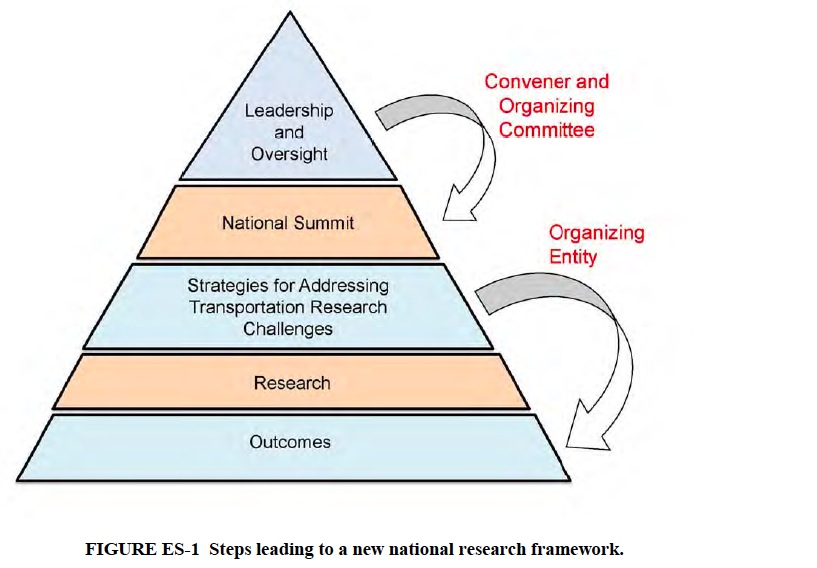TRANSPORTATION RESEARCH BOARD
Executive Summary
Over the years, surface transportation in the United States has seen numerous major improvements and policy innovations informed by research: safer and more fuel-efficient automobiles; more durable and economical pavement designs; real-time tracking of cargo shipments; and a resurgence of freight rail following deregulation of the railroad industry, to cite but a few examples. Leaders within the transportation community have questioned, however, whether the current U.S. approach to surface transportation research will lead to the innovations in transportation services and policies needed to support national goals for economic development, safety, mobility, competitiveness, and sustainability in the 21st century. The issue is rendered all the more pressing by the policy stances of a number of the United States’ competitors in Europe and Asia. These nations not only place greater emphasis on transportation research as a vital means of achieving economic, societal, and environmental goals; they also have effective frameworks for prioritizing, funding, assembling, and coordinating research activities.
In 2008, U.S. transportation research experts undertook a scanning tour of European and Asian countries, and what they saw during the tour highlighted the potential of alternative research frameworks for improving the effectiveness of transportation research in the United States. Subsequently the state departments of transportation, through the National Cooperative Highway Research Program, asked the Transportation Research Board to convene an expert committee for a follow-up assignment: to describe and evaluate potential frameworks and institutional models for surface transportation research1 in the United States that would be based on experience in the transportation sector internationally and in nontransportation sectors domestically.
The U.S. surface transportation research enterprise at present is characterized by a diversity of participants, activities, and funding sources; and it is highly decentralized, with most research programs initiated from the bottom up. As a result, much of the research aims at specific problems identified by sponsors and is relatively short term and applied in nature. Such research has led to important transportation improvements, but the imbalance between bottom-up and topdown approaches leads to missed opportunities. The U.S. system too frequently lacks clear linkages between research and national goals, and it tends to focus on solving narrowly defined problems at the expense of basic and advanced research that could form the basis for exploring broader crosscutting issues and developing innovative solutions to long-term challenges. Moreover, because research activities remain largely uncoordinated and fragmented, the integrative systems-level research needed to support national goals receives insufficient attention.
A New National Research Framework
A new and more cohesive national framework offers the opportunity to strengthen U.S. surface transportation research by establishing a holistic approach to problem solving and by building greater connectivity among researchers and research activities. To help create such a framework, the committee considered its desirable attributes, devised a framework concept, and recommended the necessary steps to develop the concept into a new national research framework (illustrated in Figure ES-1).
The committee recommends that a group of influential organizations, led by the Standing Committee on Research of the American Association of State Highway and Transportation Officials and comprised of representatives from the public, private, academic, and nonprofit sectors, should launch the framework initiative. This leadership group should assume responsibility for a national summit, which, based on the framework concept, would explore effective strategies for addressing major challenges that face surface transportation research. A subsequent report from the summit convener would examine ways of implementing the framework and funding its programs.
 Download full version (PDF): Framing Surface Transportation Research for the Nation’s Future
Download full version (PDF): Framing Surface Transportation Research for the Nation’s Future
About The Transportation Research Board
www.trb.org
“The Transportation Research Board is one of six major divisions of the National Research Council, which serves as an independent adviser to the federal government and others on scientific and technical questions of national importance. The National Research Council is jointly administered by the National Academy of Sciences, the National Academy of Engineering, and the Institute of Medicine. The mission of the Transportation Research Board is to provide leadership in transportation innovation and progress through research and information exchange, conducted within a setting that is objective, interdisciplinary, and multimodal.”
Tags: National Academies, Transportation Research Board, TRB






 RSS Feed
RSS Feed